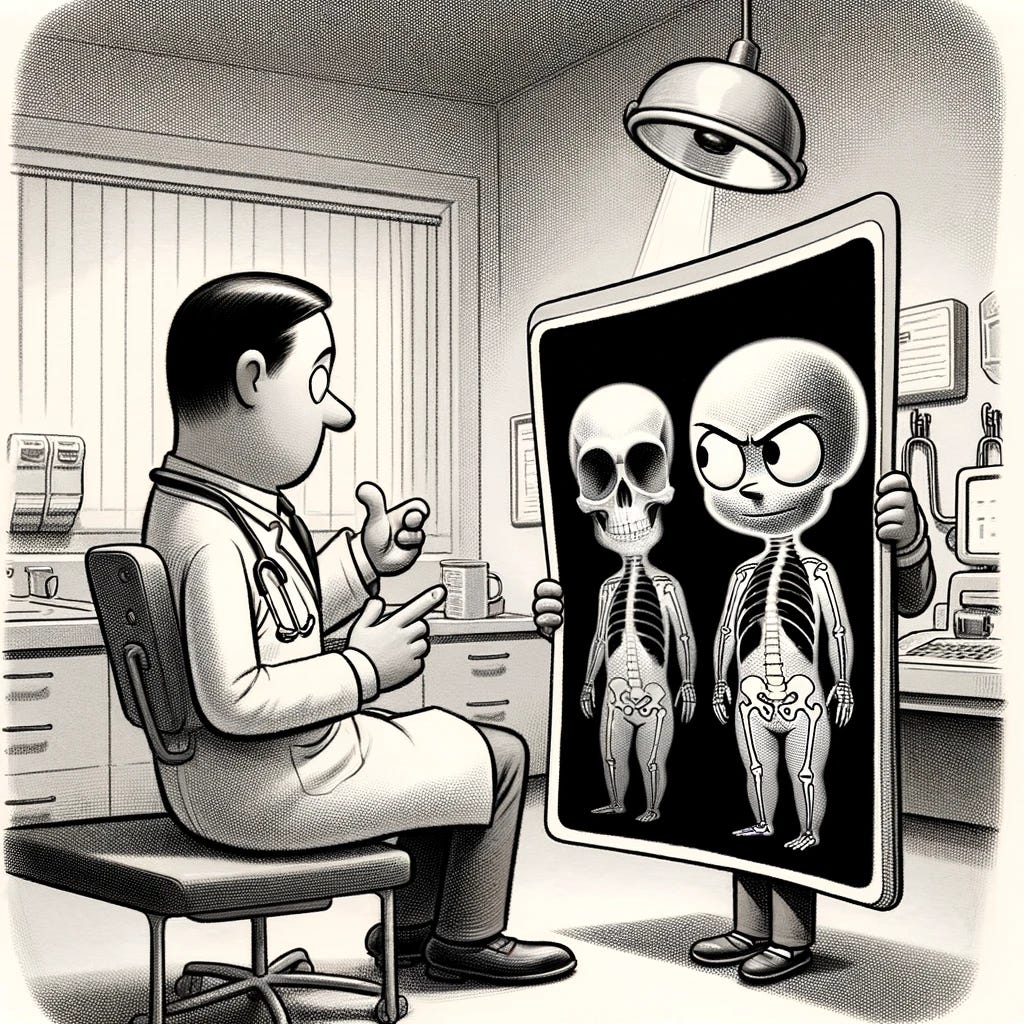Listen on Apple || Spotify || YouTube
Self-Aware X-Rays? Intelligent Objects transform healthcare with x-rays gaining AI power, allowing them to understand findings, notify doctors, access records, organize conversations, and more. EP #21
When I first heard about self-aware X-rays, it sounded like a ChatGPT hallucination. Then, discover how Intelligent Objects are digital tools with AI capabilities, allowing them to perform tasks, learn, and adapt to new situations.
Massoud blew my mind with the possibilities – smart meetings recording, summarized, and emailed automatically. Spreadsheets that notify us when problems arise or when filing deadlines arrive.
While this pod shows the x-ray example, this breakthrough applies to many business uses. In Part 2 of this interview with Massoud Alibakhsh, CEO of Omadeus, we venture into a use case study of x-rays acting as intelligent objects.
Here is a detailed summary and analysis of the The AI Optimist Episode #21 about the Aware AI X-ray:
Key Sections:
Introducing the Concept of an Aware AI X-ray (0:00-2:30)
Make the x-ray an intelligent, self-aware object through object messaging architecture.
It knows details like who took it, what type it is, and who the patient is.
It includes private channels for communicating info between doctors and nurses.
The natural language capabilities of an LLM allow it to interact with stakeholders.
It organizes conference calls and records conversations with summaries emailed to stakeholders.
Explanation of Object Messaging and Intelligent Objects (2:30-7:30)
The analogy of these objects behaving like a personal butler
They navigate workflow and deliver relevant info to stakeholders.
The objects create a harmonious flow of information attuned to the organization's tempo.
Use case of making an x-ray intelligent using object messaging architecture.
They are giving it identity details, an LLM, and communication channels to function.
Programming it to interface with workflows, databases, and stakeholder communication.
Imagining an Intelligent X-ray Object in Healthcare (7:30-end)
X-ray reads itself using NLP (natural language programming), identifies cancer, and urgently notifies the primary doctor.
It joins a conference call with a group of doctors to discuss findings.
Records call and understand conversations via NLP.
Answers later questions about itself and accesses previous call info.
Knows regulations, guidelines, and patient communication rules like HIPAA.
Fits into larger ecosystems of intelligent objects like patient records.
Featured Guest
Massoud Alibakhsh, CEO of Omadeus
Theme: AI's role in workplace efficiency, focusing on intelligent objects and object messaging
As the CEO and founder of Omadeus, Massoud leads a visionary team in creating a new paradigm of AI-powered business software based on patents pending Object Messaging and Intelligent Objects (OMIO).
The product is an AI-powered project management, collaboration, documentation, and communication unified in one application for the entire company.
The Possible Day in the Life of an Intelligent Object - an X-ray named Alex:
Meet Alex, an intelligent X-ray using object messaging architecture. Alex knows he is a chest x-ray taken of patient John Smith, age 52, by technician Jane.
Alex has natural language capabilities to discuss findings with Jane and ask clarifying questions about image quality.
After the scan, Alex reviews medical imaging guidelines and sends himself securely to the Mayo Clinic's diagnostic AI system per protocol.
He receives a textual report analyzing the images and identifying a concerning mass. Alex reads and understands this report using his language model.
Given the critical finding, he urgently contacted John Smith's oncologist, Dr. Roberts, according to physician notification rules.
Alex organizes a telehealth conference call between himself, Dr. Roberts, and an oncology specialist at Mayo Clinic, Dr. Park.
Alex displays key images, regions of concern, and report excerpts during the discussion. He records the conversation and takes notes on the recommended next steps, such as additional testing and potential treatment plans.
Two months later, Alex cross-referenced the new images and reports with his previous recordings at John's follow-up scan.
He identifies that the tumor has responded well to treatment. Alex creates a summary update for John and schedules another telehealth meeting for the care team to continue coordination.
This example demonstrates how an intelligent object like Alex takes on administrative roles, following medical regulations while interfacing with humans and AI systems using natural language and maintaining context over time. Alex also automates communication flows.
AI X-Rays as Intelligent Objects with Object Messaging
The Aware AI X-ray is a significant advancement in healthcare technology.
Integrating AI and object messaging makes the X-ray more than just a static image; it transforms into a dynamic, interactive, and intelligent entity.
This integration allows the X-ray to:
Communicate effectively with healthcare professionals and patients, providing timely and relevant information.
Connect with resources like the Mayo Clinic for advanced analysis, potentially leading to quicker, more accurate diagnoses.
Automatically comply with regulations, such as HIPAA, by staying updated with the latest guidelines and ensuring patient data privacy and security.
They enhance clinical trials, as intelligent X-rays could streamline patient selection and monitoring in cancer research and other areas.
What are the possible consequences of relying on Intelligent Objects in critical sectors like healthcare, and how might they be eased?
Relying on Intelligent Objects in healthcare may bring surprising consequences:
1. Over-reliance on Automation: Healthcare professionals become too dependent on Intelligent Objects, reducing their diagnostic or treatment skills.
Analogy: It's like someone relying solely on GPS and losing their sense of direction.
2. Malfunctions or Failures: Any technical glitch or malfunction in an Intelligent Object leads to misdiagnoses, incorrect medication dosages, or surgical mishaps.
3. Data Privacy Concerns: The collection and communication of patient data raises concerns about data privacy and potential abuse.
4. Loss of Personal Touch: With increased automation, patients feel the healthcare experience is impersonal, missing the human touch.
5. Potential for Hacking: With data exchanges between Intelligent Objects, there's an increased risk of cyber-attacks compromising patient health and information.
6. Ethical Concerns: Decisions made by Intelligent Objects may not align with ethical factors, especially in life-and-death situations.
Improvement Strategies:
1. Continuous Training: Healthcare professionals receive ongoing training to maintain their skills and aren't solely reliant on technology.
2. Redundancy Systems: Backup systems prevent complete failures. If one Intelligent Object malfunctions, another takes over.
3. Strong Data Protection: Employing encryption and strict data protection protocols to safeguard patient data.
4. Human-AI Collaboration: Ensuring decisions, especially critical ones, are made with human and AI input balances automation with the personal touch.
5. Advanced Security Protocols: Regular system updates, intrusion detection systems, and advanced firewalls help guard against cyber-attacks.
6. Ethical Guidelines: Establishing guidelines for developing Intelligent Objects ensures they align with human values.
Importance of the X-ray as an Intelligent Object Example
The Aware AI X-ray is an example of an intelligent object, demonstrating the impact of AI by transforming traditional objects into dynamic, interactive entities.
This innovation is not just technological advancement; it's reshaping how we interact with and benefit from everyday objects.
The Aware AI X-ray is a modern development in healthcare technology, demonstrating the power of integrating AI and object messaging.
This technology enhances communication, compliance, and efficiency in healthcare workflows.
The concept of intelligent objects includes applications across various sectors, offering the potential for innovation and improvement.
While Intelligent Objects revolutionize healthcare, there are potential pitfalls, including over-reliance, malfunctions, data privacy issues, loss of personal touch, security threats, and ethical dilemmas.
Mitigation strategies address these concerns, such as continuous training, redundancy, robust data protection, human-AI collaboration, advanced security measures, and ethical guidelines.
Benefits of Object Messaging in Real-Time Data-Reliant Industries:
Finance:
1. Real-time Decision Making: Trading algorithms communicate instantly with data analysis tools to make split-second buying or selling decisions based on market fluctuations.
2. Enhanced Security: Financial transactions are more secure when different security tools communicate in real-time to identify and combat threats.
3. Personalized Banking: Banking systems use Object Messaging to tailor services based on real-time customer data, like a bank teller knowing your needs.
Autonomous Vehicles:
1. Real-time Adaptation: Cars communicate with traffic lights, road sensors, and other vehicles to adjust routes, speed, or driving strategy in real time. It's like a car having a conversation with its environment.
2. Enhanced Safety: If one vehicle detects a hazard, it immediately informs nearby vehicles as a quick-reacting network.
3. Traffic Flow Optimization: Vehicles communicate to optimize traffic flow, reducing congestion and ensuring smoother rides.
Think of Object Messaging as the nervous system in a body. Finance allows the brain (algorithms) to react to stimuli (market changes) quickly.
In autonomous vehicles, it lets the car "feel" its environment and adjust accordingly.
Key Takeaways:
Object Messaging in AI can be challenging due to integration, complexity, latency, security, synchronization, and maintenance concerns.
Industries like finance and autonomous vehicles benefit from real-time decision-making, enhanced security, personalized services, and improved safety and adaptability.
Customer service chatbots draw data from various systems, addressing questions without human involvement.
In agriculture, intelligent soil sensors and robotic harvesters optimize farming practices by providing real-time data and automating labor-intensive tasks.
In finance, intelligent accounting spreadsheets incorporate rules and regulations, automatically identifying errors and notifying stakeholders, enhancing compliance and accuracy.
The key is integrating natural language processing and identity into the objects that take action within technological workflows.
Challenges for Object Messaging in Real-World AI Applications:
1. Integration with Legacy Systems: Integrating Object Messaging with older systems may lead to compatibility issues.
2. Increased Complexity: Managing communication between numerous objects adds layers of complexity. It's like orchestrating an ensemble where each instrument needs precise coordination.
3. Latency Issues: Real-time communication between objects faces delays, especially in environments with vast data transfer.
4. Security Concerns: More communication points mean potential weak spots of vulnerability.
5. Synchronization Challenges: Ensuring all objects operate harmoniously without overlapping or conflicting is challenging.
6. Maintenance: As objects increase in number and complexity, maintaining them becomes problematic.
AI Agents in 2024 will be filled with Intelligent Objects.
Next year is when AI Agents begin streamlining our personal lives. As usual, the business world is leading with Intelligent Objects and Object Messaging, making things like X-rays active participants.
Imagine a world where everyday objects are not passive items but active. Starting with the Aware AI X-ray in healthcare, we discover that this simple example replicates in finance, agriculture, and self-driving vehicles.
Name a breakthrough, and you'll likely discover these Intelligent Objects are under the hood and engaging.
Now, mundane objects are transforming into smart tools, enhancing efficiency and decision-making. It's not just about medical advances; it's about reimagining the potential of everyday objects across all sectors.
And it doesn't stop at healthcare. Think about smart soil sensors in agriculture that communicate crop needs or intelligent spreadsheets in finance that automatically flag errors and update with new regulations.
These practical, real-world applications are where AI-driven technology makes life easier, more efficient, and more informed. It's a glimpse into a future where technology integrates into every aspect of our lives, improving them.
We delve into how intelligent objects like the AI X-ray are just beginning a new era where technology and daily life intertwine in exciting ways. The possibilities are endless, and the future is now.


















